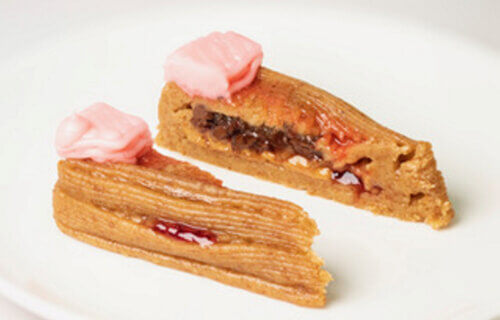NEW YORK — Watch out Cheesecake Factory: 3D-printed cheesecakes could mark the future of food, according to a new study out of Columbia university.
Scientists predict software, lasers and printers will soon replace ovens, stoves and microwaves. Cheesecakes were the perfect test. Study authors claim printing precise layers for multi-tiered food could allow users to customize items, control their nutritional content, and improve food safety.
The research shows just how far tech has come after scientists created the cheesecake using seven elements. Each layer was created on-site by a laser and edible food inks using graham crackers, peanut butter, Nutella, banana purée, strawberry jam, cherry drizzle, and frosting. Graham crackers were the best foundational ingredient, while peanut butter and Nutella ranked as the greatest supporting layers to hold softer ingredients like banana purée and jam.
The cheesecake designs evolved into multi-tiered structures created on architectural premises. In order to build several layers, more structural elements are needed to support softer substrates.
How the 3D-printed cheesecake could open doors to healthier processed food
Publishing their results in the journal Science of Food, the team hoped the sweet dessert will pave the way toward tailored nutrition. Chefs may even be able to localize flavors on a minute scale and turn them into new food experiences.
“Because 3D food printing is still a nascent technology, it needs an ecosystem of supporting industries such as food cartridge manufacturers, downloadable recipe files, and an environment in which to create and share these recipes,” says lead author Dr. Jonathan Blutinger, a postdoctoral fellow in in Professor Hod Lipson’s Creative Machines Lab, in a statement. “Its customizability makes it particularly practical for the plant-based meat market, where texture and flavour need to be carefully formulated to mimic real meats. And, with more emphasis on food safety following the COVID-19 pandemic, food prepared with less human handling could lower the risk of food-borne illness and disease transmission. This seems like a win-win concept for all of us.”
Professor Christen Cooper, from Pace University Nutrition and Dietetics, believes the new technology could tackle low-nutrient food. “We have an enormous problem with the low-nutrient value of processed foods,” she says. “3D food printing will still turn out processed foods, but perhaps the silver lining will be, for some people, better control and tailoring of nutrition-personalized nutrition. It may also be useful in making food more appealing to those with swallowing disorders by mimicking the shapes of real foods with the pureed texture foods that these patients – millions in the U.S. alone – require.”
Despite the breakthrough, Lipson notes more research needs to be done. “The study also highlights that printed food dishes will likely require novel ingredient compositions and structures, due to the different way by which the food is ‘assembled.’ Much work is still needed to collect data, model, and optimize these processes.”

South West News Service writer Pol Allingham contributed to this report.
